The Vermin of the Skies
The asteroid belt is a collection of small rocky worlds, ranging in size from pebbles to the dwarf planet Ceres, which is almost a thousand kilometres across. Located in orbit between Mars and Jupiter they have been an important site in the imagination of both SF writers and scientists alike.
The first asteroids were detected in the early 1800s, as telescopes became more common and their use more systematic. The first few to be detected, amongst them Ceres (discovered on 1st January 1801, heralding the nineteenth century), Pallas, Juno and Vesta, were initially classified as planets, since they orbited the Sun in the ecliptic plane and so moved against the background stars. However as telescopes became more sensitive and observations more exacting, it was soon realised that not just dozens but hundreds or thousands of objects must form a ring around the Sun, unlike the situation found in the orbit of any of the classical planets. As a result of their variety and numbers, all these bodies were reclassified as asteroids or (more formally) minor planets. More recently, Ceres alone has gone some way towards recovering its classification and is now officially recognised as a dwarf planet.
The Lost World
The initial enthusiastic acceptance of Ceres as a new world in the Solar System owed largely to an expectation that a planet should indeed circle the Sun in an orbit between Mars and Jupiter. By the mid-eighteenth century it had been noticed that the classical planets appeared to follow a mathematical progression in their orbital distances that is described as the Titius-Bode Law. However this progression identified a gap between Mars and Jupiter in which a planet would be expected. Beyond Saturn, Uranus was found to satisfy the law on its discovery [1], hence expectations for the orbits sunwards of Jupiter were raised - only to lead to confusion when it was discovered that the asteroid belt (rather than a single large object) occupies the predicted position.
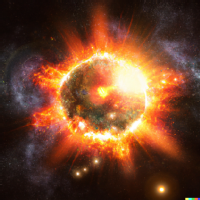 Perhaps understandably then, a theory was proposed by Heinrich Olbers (the discoverer of minor planets Pallas and Vesta) that a major planet had indeed once existed in this orbit, but had somehow been destroyed and fragmented at some point in the past. This narrative became popular in both scientific and popular circles, and the hypothetical planet was (sometimes but not always) dubbed Phaeton. Science fiction naturally reflects the interest in this supposedly-lost world, and continued to do so even as the hypothesis fell out of scientific favour. The idea that something as large as a planet could be destroyed both horrified and appealed to audiences, and - particularly in the mid twentieth century when the world-shattering potential of nuclear weaponry was recognised - suggested a deep suspicion of the scientific theories and processes that might release enough energy for the task.
Perhaps understandably then, a theory was proposed by Heinrich Olbers (the discoverer of minor planets Pallas and Vesta) that a major planet had indeed once existed in this orbit, but had somehow been destroyed and fragmented at some point in the past. This narrative became popular in both scientific and popular circles, and the hypothetical planet was (sometimes but not always) dubbed Phaeton. Science fiction naturally reflects the interest in this supposedly-lost world, and continued to do so even as the hypothesis fell out of scientific favour. The idea that something as large as a planet could be destroyed both horrified and appealed to audiences, and - particularly in the mid twentieth century when the world-shattering potential of nuclear weaponry was recognised - suggested a deep suspicion of the scientific theories and processes that might release enough energy for the task.
Numerous examples of fifth-planet stories exist in the SF corpus. In some, such as the Thunderbirds novel “Operation Asteroids” (Jennison, 1966), the former existence of a planet is mentioned in passing rather than forming the focus of the story. In others the inhabitants of the fifth planet or traces of their civilisation are found and investigated. This is the case in W E Johns' Kings of Space series, where the residents of the planet Kraka are seen as being the likely architects of their own destruction:
“It was a day of universal calamity, the cause of which was not known. It began at Kraka, the home of great scientists. That was certain, because Martian ships, and others in outer space, had seen the flash of the explosion that had destroyed it utterly, breaking it into fragments, some of which they could see. [...] There were some, continued Vargo, who believed that the cause of the disaster was a collision with a great meteor that came from outer space, where such things were not uncommon. Others disputed this, saying that the approach of such a visitor would have been noted and a warning given. They believed that the catastrophe was caused by an ill-advised experiment on Kraka that had cracked the hard crust of the planet so its molten heart had burst asunder.” (Return to Mars, Johns 1955, Armada paperback edn 1970, pg 80-81)
The resulting disruption of the Solar System rendered the Mars of Johns' universe uninhabitable, leading to Martians migrating to the larger asteroids. Such self-destruction was a common trope in the 1950s and 60s, reflecting cold-war anxieties regarding the nuclear threat.
In other narratives the residents were innocent victims. Charles Chilton’s radio drama Space Force 2 (BBC radio, 1985), for example, suggests that the planet was drawn into a resonant orbit with Jupiter and gradually torn apart by tidal forces - a suggestion drawn directly from (by then outdated) scientific theory. Strikingly, Chilton imagined the survivors of his disaster teaching the Egyptian civilisation (a familiar aliens-among-us trope). He described the survival of a “golden asteroid” as the remnant of the original planet’s core, and indicated that it was comprised of an unusual material called sunstone, reminiscent of the orichalcum that Johns had proposed as originating in his earlier lost world. The television series Doctor Who (“Image of the Fendahl”, 1977), by contrast, offers an external threat, suggesting that the planet was removed from time and space by the Time Lords in order to imprison an entity known as the Fendahl, and that the remaining debris had gathered since its removal [2].
By the 1960s the fifth planet hypothesis has fallen out of fashion in scientific research [3], in favour of models which suggest a planet never formed (due to gravitational disruption of the proto-planetary disk). Indeed, as early as 1953, Isaac Asimov’s juvenile novel Lucky Starr and the Pirates of the Asteroids explained that “It was Jupiter that was the villain. [...] The cosmic gravel between itself and Mars could never coalesce into a single planet with Jupiter pulling and pulling.” (NEL edition 1974, pg 19)
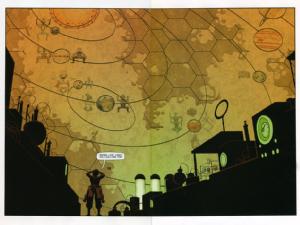 However the numerous examples of lost-planet stories found in much later science fiction suggest that the idea lingered in popular culture for significantly longer. A recent, pleasing homage to older science fiction can be found in the graphic novel Scarlet Traces (vol 2: The Great Game, 2006, by Ian Edginton and D’Israeli). Here, the “Martians” of H G Wells’ The War of the Worlds (1898) are revealed to originate from a lost fifth planet, as illustrated in a diagram of the pre-historic Solar System which shows the Earth to be inhabited by Silurians and Sea Devils (from the Doctor Who universe), the Moon by Selenites (from H G Wells’ The First Men in the Moon), Venus by Treens and Therons (from Dan Dare, which also provides the Mercurians) and Mars by Green Martians (from Edgar Rice Burroughs’ Barsoom stories) and by races from C S Lewis’ Out of the Silent Planet.
However the numerous examples of lost-planet stories found in much later science fiction suggest that the idea lingered in popular culture for significantly longer. A recent, pleasing homage to older science fiction can be found in the graphic novel Scarlet Traces (vol 2: The Great Game, 2006, by Ian Edginton and D’Israeli). Here, the “Martians” of H G Wells’ The War of the Worlds (1898) are revealed to originate from a lost fifth planet, as illustrated in a diagram of the pre-historic Solar System which shows the Earth to be inhabited by Silurians and Sea Devils (from the Doctor Who universe), the Moon by Selenites (from H G Wells’ The First Men in the Moon), Venus by Treens and Therons (from Dan Dare, which also provides the Mercurians) and Mars by Green Martians (from Edgar Rice Burroughs’ Barsoom stories) and by races from C S Lewis’ Out of the Silent Planet.
Swarms of Vermin
Asteroidal bodies move relatively quickly across the background stars. As a result, they will be present in some images of the sky and not others of the same location at a different time, or, in longer exposures, they can leave bright streaks across images designed to look for faint distant sources. For astronomers searching large areas of the sky for supernovae and other changing objects, asteroids were (and are) a constant pest - hence their soubriquet as vermin of the skies. This nickname was invoked by Arthur C Clarke in his Rendezvous with Rama (1973), as well as by the character Brains in Thunderbirds: Operation Asteroids (1966), and by Angus McVicar in his The Lost Planet (novel 1953, TV series 1954).
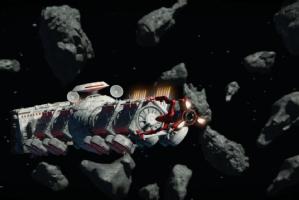 In many cases the phrase is used to convey the image of swarming, innumerable rocks presenting a threat - as is the case for The Lost Planet (where it is in-fact used to describe a near-Earth swarm of meteor dust rather than main belt asteroids). This is the image of crowded asteroids conjured by the exo-asteroidal belt famously shown, for example, in Star Wars: The Empire Strikes Back (1980) - with huge rocks passing one another by a hair’s breadth or crashing together - or in numerous video games inspired by the film. More recently, an episode of animated television series Thunderbirds Are Go (“Colony”, 2016) showed a colony ship heading for Mars overshooting and ending up in an asteroid belt so crowded that a rescue craft had to try to shoot apart those in the path of the ship, hitting a city-block sized planetoid every few seconds. Even popular science magazines such as New Scientist are prey to this kind of crowded imagery, meeting the science-fiction-informed expectations of their audience rather than reflecting the factual situation.
In many cases the phrase is used to convey the image of swarming, innumerable rocks presenting a threat - as is the case for The Lost Planet (where it is in-fact used to describe a near-Earth swarm of meteor dust rather than main belt asteroids). This is the image of crowded asteroids conjured by the exo-asteroidal belt famously shown, for example, in Star Wars: The Empire Strikes Back (1980) - with huge rocks passing one another by a hair’s breadth or crashing together - or in numerous video games inspired by the film. More recently, an episode of animated television series Thunderbirds Are Go (“Colony”, 2016) showed a colony ship heading for Mars overshooting and ending up in an asteroid belt so crowded that a rescue craft had to try to shoot apart those in the path of the ship, hitting a city-block sized planetoid every few seconds. Even popular science magazines such as New Scientist are prey to this kind of crowded imagery, meeting the science-fiction-informed expectations of their audience rather than reflecting the factual situation.
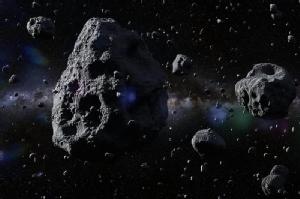 In fact the asteroid belt is very sparsely populated. Its total mass is less than a thousandth of that of Earth, with almost two thirds of this concentrated in the four largest bodies and the rest spread over a volume unimaginably large. Most vessels in the asteroid belt would know little about it, except for perhaps a slightly higher density of faint “stars” in the sky. Any system as dense as those more typically shown in science fiction, and certainly any dense enough for frequent collisions, would be highly unstable and grind itself to dust in a tiny fraction of the age of the Solar System. The actual risk of impact between asteroids or on a given space vessel is microscopically small - as indeed characters in science fiction often comment immediately before the inevitable, narrative-demanded collision. An example here can be found in Isaac Asimov’s 1939 short story “Marooned Off Vesta” in which a spaceship is wrecked by such a collision, leaving its crew to find a way to the settlement on the titular asteroid.
In fact the asteroid belt is very sparsely populated. Its total mass is less than a thousandth of that of Earth, with almost two thirds of this concentrated in the four largest bodies and the rest spread over a volume unimaginably large. Most vessels in the asteroid belt would know little about it, except for perhaps a slightly higher density of faint “stars” in the sky. Any system as dense as those more typically shown in science fiction, and certainly any dense enough for frequent collisions, would be highly unstable and grind itself to dust in a tiny fraction of the age of the Solar System. The actual risk of impact between asteroids or on a given space vessel is microscopically small - as indeed characters in science fiction often comment immediately before the inevitable, narrative-demanded collision. An example here can be found in Isaac Asimov’s 1939 short story “Marooned Off Vesta” in which a spaceship is wrecked by such a collision, leaving its crew to find a way to the settlement on the titular asteroid.
Given the apparent threat then, the question remains: why do space ships in science fiction continually venture into the asteroid belt? For those en route to Jupiter or the outer planets (as was the case for Space Force, BBC radio 1983, for example), this is frankly baffling - suitable transfer orbits swinging above and below the narrow plane of the belt exist and this has been understood since the early twentieth century. As one of the characters In 1939 story "Marooned Off Vesta" notes:
“You’ve got to expect things like this to happen sometimes. Bucking the asteroids is risky business. We should have taken the hop. It takes longer, but it’s the only safe way. But no, the captain wanted to make the schedule; he would go through.
However for a substantial number of narratives, the asteroids themselves are the target of such journeys. Typically this is for one of two motives: mining or settlement.
The New Wild West
Science fiction's recognition of the potential of the asteroid belt as a source of minerals dates back at least to 1932 and Clifford Simak’s “The Asteroid of Gold”. Five decades later, in Space Force 2, writer Charles Chilton was explicit about his fleet’s goal on reaching the asteroids:
“Various exploratory expeditions will then be launched: first to the larger asteroids, and then to the smaller, to ascertain their mineral content and how it may be extracted.”
The same motivation can be found in much of the corpus of asteroid-belt stories.
Author Poul Anderson effectively captured both mining and settlement aspects of the asteroid belt in two short stories chosen by other editors to represent the Asteroid Belt in science fiction anthologies about the Solar System. “Barnacle Bull” (1960, anthologised by Asimov in The Science Fictional Solar System, 1980) follows a Norwegian national crew aiming to make the first successful return trip to the asteroid belt, and makes their motivation clear:
“The asteroids had all the minerals man would ever need, in developing his extraterrestrial colonies and on Earth herself. Freely available minerals, especially on the metallic asteroids from the core of the ancient planet. Just land and help yourself. No elaborate apparatus needed to protect you from your environment. Just the spaceship and the space armour you had to have anyway. No gravitational well to make down into and climb back out of. Just a simple thrust of minimal power”
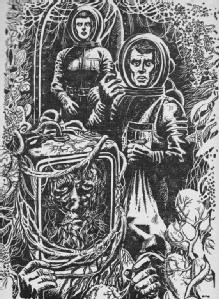 The same mining goals form the motivation for mineral prospectors described in the same author’s “Garden in the Void” (1952, anthologised by Mike Ashley in Born of the Sun, 2020), which imagines a later phase of exploitation by small independent contractors, and the life of a stranded spaceman in a curious pocket of unlikely asteroidal life. While the plausibility of the biology in this story is rather strained, the story effectively captures the idea of isolation and the potential for island-like privacy and autonomy if the miniature worlds of the belt were settled. Together with “Marooned off Vesta” and others, it also emphasises the risks that might be taken by those living and working in a region of such low population density, surrounded in the hostile vacuum.
The same mining goals form the motivation for mineral prospectors described in the same author’s “Garden in the Void” (1952, anthologised by Mike Ashley in Born of the Sun, 2020), which imagines a later phase of exploitation by small independent contractors, and the life of a stranded spaceman in a curious pocket of unlikely asteroidal life. While the plausibility of the biology in this story is rather strained, the story effectively captures the idea of isolation and the potential for island-like privacy and autonomy if the miniature worlds of the belt were settled. Together with “Marooned off Vesta” and others, it also emphasises the risks that might be taken by those living and working in a region of such low population density, surrounded in the hostile vacuum.
Although iron-cored asteroids are now considered unlikely to be remnants of the fifth planet, as earlier stories suggested, the mining paradigm can be found in both academic science writing and in science fiction right up to the current time, with examples ranging from the works of Robert Heinlein, Mack Reynolds, and Isaac Asimov, to more recent narratives by James S A Corey and others. A recent example - reacting to modern computer technology - can be found in Thunderbirds are Go (“Slingshot”, 2015) in which one of the main-belt asteroids, 21 Lutetia, is host to an automated mining station with a single human monitor [4] - the implication here is such operations are routine by the 2060s. In some science fiction examples, the asteroid belts being mined are actually extra-solar, with examples dating back to E E “Doc” Smith's Lensman series and beyond. In recent years the focus in academia and proposals for commercial utilisation of asteroids in our own solar system has shifted from an emphasis on basic materials such as iron to the rarer metallic elements required for modern electronics.
However science fiction also highlights the potential problems that a new “gold rush” to space might encounter. In Lucky Starr and the Pirates of the Asteroids, Isaac Asimov spelled out the problem of governing the asteroid belt:
“Any criminal who could escape to the asteroids was safe from capture by all but the most improbable chance. No police force could search every one of those flying mountains.The smaller asteroids were no man’s land. There were well-manned astronomical observatories on the largest, notably on Ceres. There were beryllium mines on Pallas, while Vesta and Juno were important fuelling stations. But that still left fifty thousand sizeable asteroids over which the Terrestrial Empire had no control whatever.” (NEL edition 1974, pg 20).
While this story imagines the asteroid belt as home to organised bands of bandits preying on interplanetary travel, more commonly science fiction portrays asteroid miners as fiercely independent, more akin to Anderson’s stranded explorer. With prospectors searching out valuable minerals, staking claims and living in small, isolated outposts, perhaps it's unsurprising that one of the most common paradigms regarding life in the asteroid belt is analogous to the American Wild West. Here the few largest asteroids take the role of cities - hubs of commerce and transportation - while the remainder are individual home stakes or small settlements. Often a lawless and libertarian zone, it attracts non-conformist and free-thinking independent individuals. This paradigm can be found amongst the belters of Larry Niven’s Tales of Known Space, amongst the prospectors in Heinlein’s novels such as The Rolling Stones, in E E Doc Smith’s extrasolar asteroid miners, and can even be seen in recent science fiction such as James S A Corey’s The Expanse series of novels (and television series) in which the independence-seeking Belters actually form an alliance to fight a war against the inner planets.
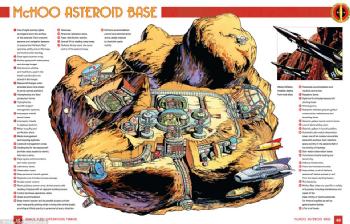 The potential for independent settlement and lack of political oversight also manifests in other narratives of asteroid settlement beyond the Space Westerns. Here maverick geniuses and/or wronged individuals make use of the isolation of the asteroid belt to create a private domain in which they are able to settle without interference. A notable example in this category is the McHoo asteroid in the Dan Dare universe. This is a fully functioning settlement buried within a hollowed-out asteroid by a disaffected genius, and is unknown to the interplanet space fleet until Dan Dare is kidnapped and taken there. Indeed, the McHoo asteroid base goes significantly beyond the stereotype of loner individualists, with McHoo’s vision guiding an entire industrial and commercial organisation.
The potential for independent settlement and lack of political oversight also manifests in other narratives of asteroid settlement beyond the Space Westerns. Here maverick geniuses and/or wronged individuals make use of the isolation of the asteroid belt to create a private domain in which they are able to settle without interference. A notable example in this category is the McHoo asteroid in the Dan Dare universe. This is a fully functioning settlement buried within a hollowed-out asteroid by a disaffected genius, and is unknown to the interplanet space fleet until Dan Dare is kidnapped and taken there. Indeed, the McHoo asteroid base goes significantly beyond the stereotype of loner individualists, with McHoo’s vision guiding an entire industrial and commercial organisation.
This aspect of asteroid belt fiction is perhaps amongst the most relevant to today’s rise in commercial spaceflight interests, which parallel and at times exceed those of governments. The role of maverick wealthy individuals in funding space exploration - many of whom are themselves science fiction enthusiasts - is perhaps reminiscent of McHoo and the other science fiction eccentrics. The comparative lack of a robust legislative framework to govern space resource utilisation offers freedom of action and potentially high profits… but these are dependent on a reliable and inexpensive lift capacity to orbit - something that has held back the science fiction vision of space settlement and asteroid mining for decades, and remains to be resolved.
In actual fact, asteroid mining has been considered a decade or two away from implementation for almost a century now, and there is little reason to believe that it is any more likely to be financially viable in the coming decade than in the last. While progress is being made it remains slow, and there is still a long way to go before crewed human space flight can plausibly reach the asteroid belt. However, not only has science fiction inspired the entrepreneurs, scientists and engineers most likely to bring this dream to fruition, it has also inspired constitutional theorists, experts and the others who are even now considering the legal framework that such endeavours would require. Fiction has also highlighted both the potential benefits and the potential risks of exploring this new frontier. Safety and logistics planners for a future mission could do a whole lot worse than examining the century of science fiction that brainstorms the future they’ll be creating.
“The Vermin of the Skies”, Elizabeth Stanway, Cosmic Stories blog. 2nd October 2022
Notes:
[1] Dwarf planet Pluto also occupies a Bode’s Law privileged position, while the peculiar planet Neptune is an interloper. The law is not easily explained but almost certainly arises from a series of gravitational resonances between the Sun and its planets, particularly the gas giant Jupiter, which render certain orbits more stable than others. Similar mathematical progressions are seen in the moon systems of the giant planets and are also determined by gravitational resonances. [Return to text]
[2] The extended Doctor Who universe of novels and audio adventures includes several alternate explanations for the fate of planet 5 - none of them terribly plausible, but all confirming the continuing attraction of the lost-planet paradigm. [Return to text]
[3] A brief revival of the fifth-planet idea in the 1970s was rapidly and comprehensively disproved based on the energy requirements and implications for the rest of the solar system. [Return to text]
[4] In the episode, 21 Lutetia is described as having a molten core and and accidental breach of it leads to the asteroid being thrown into a sungrazing orbit. The energy and angular momentum requirements for this manoeuvre are best not considered too closely - which is ironic since the bulk of the episode focuses on the orbital dynamics required for escape. It’s also unlikely that any of the asteroids (dwarf planet Ceres included) are sufficiently large to host molten cores. [Return to text]
All opinions expressed here are my own and do not necessarily reflect the opinions of the University of Warwick.
Images sourced from public sources online and used here for comment and criticism under fair use provisions.
